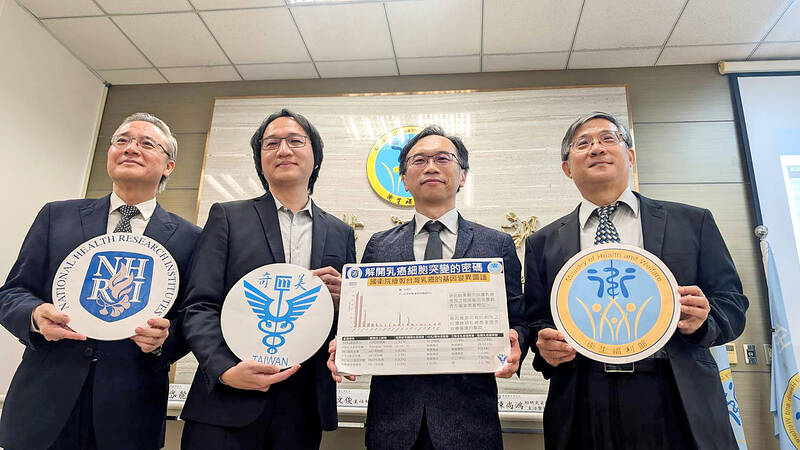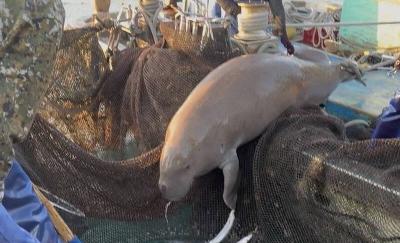Scientists have completed the first-ever genetic mapping of tumor cells from Taiwanese with breast cancer in a potential breakthrough for treatment and prevention of the disease.
National Cancer Research Institute director Cha Tai-lung (查岱龍) said that the genetic flaws linked to breast cancer are passed down within subpopulations, complicating attempts to apply research conducted on one group to another.
People with Jewish heritage are more likely to develop breast cancer from mutations in BRCA1 and BRCA2 gene markers, a condition that is far less likely to develop in other ethnicities, Cha said.

Photo: CNA
East Asian women develop breast cancer at a younger age than people of European descent, institute assistant research fellow Chen Shang-hung (陳尚鴻) said, adding that and the most common age that Taiwanese women develop breast cancer is 45 to 55, 10 years younger than Caucasian women.
This means that breast cancer results in a greater economic burden on Taiwanese families and the healthcare system, but no genetic mapping of tumors had been done in the nation until now, Chen said.
Institute researchers used next-generation sequencing technology to map tumor tissue samples from 116 Taiwanese with breast cancer and compared the results with data from the New York-based Memorial Sloan Kettering Cancer Center, he said.
The research, “Comprehensive genomic profiling and therapeutic implications for Taiwanese patients with treatment-naive breast cancer” — which included the “domestic breast cancer gene variation map” — was published in the Cancer Medicine journal on June 19.
They found that mutations of seven genetic markers were common among Taiwanese breast cancer patients, a result broadly comparable, but not identical, to markers in Western patients, he said.
The discovery suggests that targeted therapy drugs would work on 40 percent of Taiwanese patients and opened new avenues of research on the cause of mammary cancer in the local population, he said.
If mutations of the genetic markers in Taiwanese are about the same as in Westerners, then other environmental, behavioral or unforeseen mechanisms must be at play for their younger age, Chen said.
The factors could be related to diet, cultural habits or an unknown genetic marker, he said.
Changes to mRNA or protein expression are from causes other than genetic mutations, and could spark cancer development and affect the severity of the disease, National Health Research Institutes secretary-general Hung Wen-Chun (洪文俊) said.
The institute would continue exploring the causes of breast cancer among Taiwanese, Hung said.

‘DENIAL DEFENSE’: The US would increase its military presence with uncrewed ships, and submarines, while boosting defense in the Indo-Pacific, a Pete Hegseth memo said The US is reorienting its military strategy to focus primarily on deterring a potential Chinese invasion of Taiwan, a memo signed by US Secretary of Defense Pete Hegseth showed. The memo also called on Taiwan to increase its defense spending. The document, known as the “Interim National Defense Strategic Guidance,” was distributed this month and detailed the national defense plans of US President Donald Trump’s administration, an article in the Washington Post said on Saturday. It outlines how the US can prepare for a potential war with China and defend itself from threats in the “near abroad,” including Greenland and the Panama

A wild live dugong was found in Taiwan for the first time in 88 years, after it was accidentally caught by a fisher’s net on Tuesday in Yilan County’s Fenniaolin (粉鳥林). This is the first sighting of the species in Taiwan since 1937, having already been considered “extinct” in the country and considered as “vulnerable” by the International Union for Conservation of Nature. A fisher surnamed Chen (陳) went to Fenniaolin to collect the fish in his netting, but instead caught a 3m long, 500kg dugong. The fisher released the animal back into the wild, not realizing it was an endangered species at

The Chinese Nationalist Party (KMT) is maintaining close ties with Beijing, the Democratic Progressive Party (DPP) said yesterday, hours after a new round of Chinese military drills in the Taiwan Strait began. Political parties in a democracy have a responsibility to be loyal to the nation and defend its sovereignty, DPP spokesman Justin Wu (吳崢) told a news conference in Taipei. His comments came hours after Beijing announced via Chinese state media that the Chinese People’s Liberation Army’s Eastern Theater Command was holding large-scale drills simulating a multi-pronged attack on Taiwan. Contrary to the KMT’s claims that it is staunchly anti-communist, KMT Deputy

The High Prosecutors’ Office yesterday withdrew an appeal against the acquittal of a former bank manager 22 years after his death, marking Taiwan’s first instance of prosecutors rendering posthumous justice to a wrongfully convicted defendant. Chu Ching-en (諸慶恩) — formerly a manager at the Taipei branch of BNP Paribas — was in 1999 accused by Weng Mao-chung (翁茂鍾), then-president of Chia Her Industrial Co, of forging a request for a fixed deposit of US$10 million by I-Hwa Industrial Co, a subsidiary of Chia Her, which was used as collateral. Chu was ruled not guilty in the first trial, but was found guilty